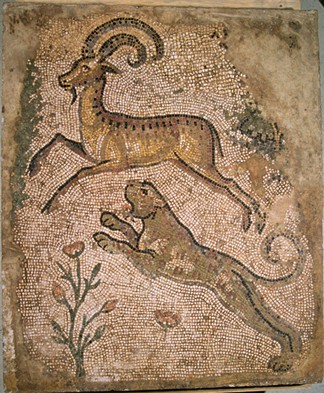Mike Abrams enriches building that inspired him with gift of fifth-century mosaic
By Susan Robertson
Sitting at the desk in his Goldwin Smith Hall office, M.H. (Mike) Abrams wrote his acclaimed books of literary criticism and presided over multiple editions of his "Norton Anthology of English Literature." Now the building that was central to his academic life is in turn being enriched by a singular gift.
The handsome, plaster casts of Greek figures and chalk-light walls inside the south entrance to Goldwin Smith surround a large mosaic of a lioness attacking an ibex, rendered in realistic colors by Roman craftsmen in Syrian Antioch between 450 and 550 A.D.
The stunning mosaic is one of many gifts from the 95-year-old Abrams, Class of 1916 Professor of English Emeritus, and wife Ruth to the Herbert F. Johnson Museum of Art. The mosaic had previously been displayed in the entrance hall of the Abramses' former home (they now live at Kendal at Ithaca).
"It is unusually good and, in fact, it would be one of the standouts in any exhibit of mosaics from Roman Syria," says Franklin W. Robinson, the Richard J. Schwartz Director of the museum. The "lioness" scene was created by a team of artists who embedded the precisely shaped tesserae (small blocks cut from colored stone) in lime mortar, an ancient version of concrete. The resulting mosaic will last, in Robinson's view, "as forever as anything can, in works of art."
Three of the four Antioch mosaics owned by the Abramses are now part of the Johnson Museum's collection. The "lioness" mosaic is actually a large fragment of a floor from a public building -- most likely an early Christian-Roman church, Abrams explains. "Typically, the churches gave symbolic, religious significance to the images of the natural world that were part of the style and artistry of Rome." They created their own version of the figural mosaic floors that decorated the homes of wealthy Romans.
Rather than having an exclusive interest in Roman artifacts, over the years the Abramses acquired art that appealed to them: Chinese ceramics, Renaissance paintings, British watercolors, Roman glass, Indian and Persian miniatures, pre-Columbian pottery and many modern pieces. Undoubtedly, the most surprising work in the collection is an Etch A Sketch drawing made by friend Frank Stella, the notable American minimalist painter, during an Abrams family party. Several pieces by Cornell artists and friends signify important relationships during the couple's 63 years in Ithaca.
"Like many of the works I've given to the museum, 'lioness' was shown only occasionally because the holdings rotate and then disappear," Abrams says. So Robinson was enthusiastic when Abrams suggested placing it near the classics department. "The anchor of the extraordinary pieces of ancient and neoclassical art displayed in Goldwin Smith is this wonderful mosaic, now very visible," says Robinson.
In the near future, the museum will place a second Abrams mosaic near "lioness."
Susan Robertson is director of communications for the College of Arts and Sciences.
Media Contact
Get Cornell news delivered right to your inbox.
Subscribe